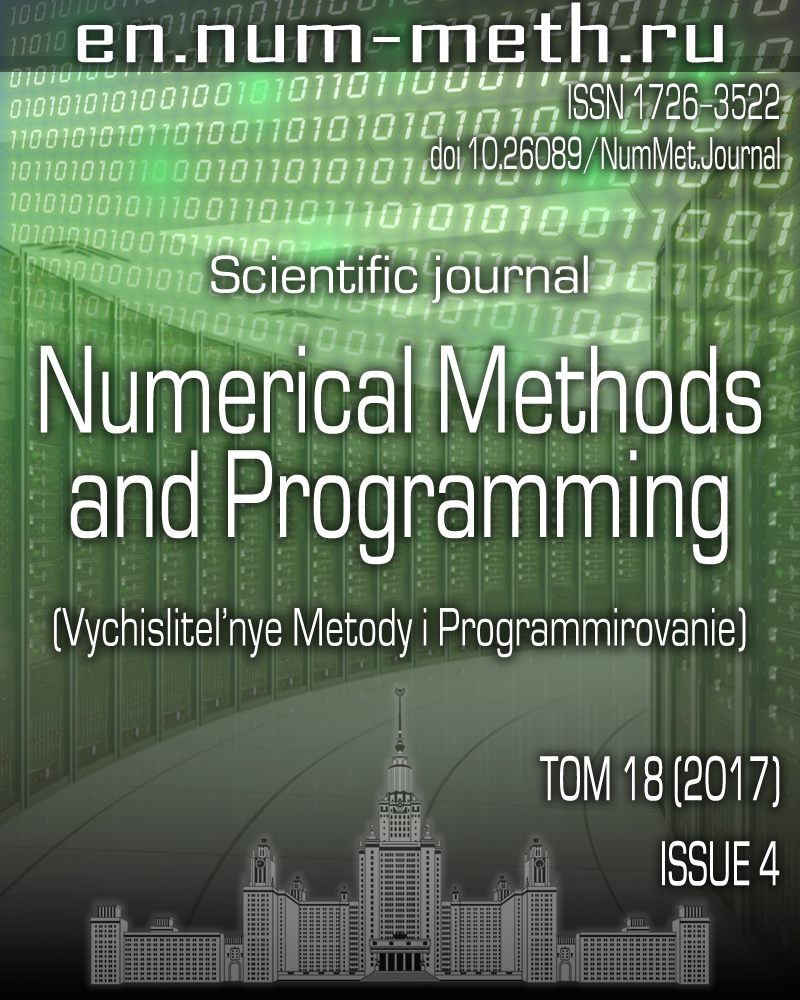DOI: https://doi.org/10.26089/NumMet.v18r435
A numerical method to estimate the effective elastic moduli of rocks from two- and three-dimensional digital images of rock core samples
Keywords:
Abstract
A numerical method to estimate the effective elastic moduli of rocks from two- and three-dimensional digital images of rock core samples is proposed. The method is based on the energy equivalence principle for deformations caused by the homogeneous boundary static conditions that simulate a physical experiment. On this basis, the effective compliance tensor of a representative volume of an inhomogeneous medium is determined. A specific feature of the proposed algorithm is a new scheme for calculating the stress-strain static state of a sample by solving the corresponding problem of dynamic elasticity theory using the relaxation method. The obtained numerical results are discussed. The proposed method is verified using homogeneous samples with specified properties as well as for layered materials with effective parameters obtained according to the Schoenberg method. In conclusion, the effective parameters for a three-dimensional core sample are presented.
Published
Issue
Section
References
- A. S. Alekseev, V. I. Kostin, V. G. Khaidukov, and V. A. Cheverda, “Recovery of Two-Dimensional Perturbations of the Velocity of a Vertically-Inhomogeneous Medium from Multicoverage Data (Linearized Formulation),” Geolog. Geofiz. 38 (12), 1980-1992 (1997) [Russ. Geol. Geophys. 38 (12), 2012-2025 (1997)].
- M. I. Protasov and V. A. Cheverda, “True-Amplitude Seismic Imaging,” Dokl. Akad. Nauk 407 (4), 528-532 (2006) [Dokl. Earth Sci. 407 (2), 441-445 (2006)].
- V. V. Lisitsa, V. A. Pozdnyakov, G. V. Reshetova, et al., “Scattered Seismic Responses: Simulation and Imaging. Part 1. Two-Dimensional Media,” Tekhnol. Seismorazvedki, No. 1, 46-58 (2013).
- M. I. Protasov, G. V. Reshetova, and V. A. Tcheverda, “Recovery of Fracture Zones by Weighted Summation of Multicomponent Data and Image Spectrum Analysis,” Tekhnol. Seismorazvedki, No. 1, 59-66 (2014).
- M. I. Protasov, G. V. Reshetova, and V. A. Tcheverda, “3D Diffraction Imaging of 3D Seismic Data on the Basis of Asymmetric Summation and Spectral Filtering,” Geofizika, No. 2, 14-21 (2017).
- K. G. Gadylshin, D. R. Kolyukhin, V. V. Lisitsa, et al., “Use of Scattered Wavefield to Locate Fine Cavernous Layers in Fractured Formations of Yurubcheno-Tokhomskoe Field,” Tekhnol. Seismorazvedki, No. 1, 56-62 (2017).
- M. K. Ivanov, Yu. K. Burlin, G. A. Kalmykov, et al., Petrophysical Methods of Studying a Core Material (Terrigenous Deposits) (Mosk. Gos. Univ., Moscow, 2008) [in Russian].
- H. Andra, N. Combaret, J. Dvorkin, et al., “Digital Rock Physics Benchmarks - Part I: Imaging and Segmentation,” Comput. Geosci. 50, 25-32 (2013).
- H. Andra, N. Combaret, J. Dvorkin, et al., “Digital Rock Physics Benchmarks - Part II: Computing effective properties,” Comput. Geosci. 50, 33-43 (2013).
- R. Sain, Numerical Simulation of Pore-Scale Heterogeneity and its Effects on Elastic, Electrical and Transport Properties, PhD Thesis (Stanford Univ., Stanford, 2010).
- Ya. Bazaikin, B. Gurevich, S. Iglauer, et al., “Effect of CT Image Size and Resolution on the Accuracy of Rock Property Estimates,” J. Geophys. Res. 122 (5), 3635-3647 (2017).
- T. D. Shermergor, The Theory of Elasticity of Microinhomogeneous Media (Nauka, Moscow, 1977) [in Russian].
- G. P. Sendeckyj (Ed.), Composite Materials , Vol. 2: Mechanics of Composite Materials (Academic, New York, 1974; Mir, Moscow, 1978).
- R. M. Christensen, Mechanics of Composite Materials (Wiley, New York, 1979; Mir, Moscow, 1982).
- J. Aboudi, Mechanics of Composite Materials: A Unified Micromechanical Approach (Elsevier, Amsterdam, 1991).
- W. Zhang, G. Dai, F. Wang, et al., “Using Strain Energy-Based Prediction of Effective Elastic Properties in Topology Optimization of Material Microstructures,” Acta Mech. Sin. 23 (1), 77-89 (2007).
- N. Saxena and G. Mavko, “Estimating Elastic Moduli of Rocks from Thin Sections: Digital Rock Study of 3D Properties from 2D Images,” Comput. Geosci. 88, 9-21 (2016).
- N. S. Bakhvalov, N. P. Zhidkov, and G. M. Kobelkov, Numerical Methods (Nauka, Moscow, 2013) [in Russian].
- A. A. Samarskii and A. V. Gulin, Numerical Methods of Mathematical Physics (Nauchnyi Mir, Moscow, 2003) [in Russian].
- Y. Saad, Iterative Methods for Sparse Linear Systems (SIAM Press, Philadelphia, 2003; Mosk. Gos. Univ., Moscow, 2013).
- Y. A. Erlangga, C. Vuik, and C. W. Oosterlee, “On a Class of Preconditioners for Solving the Helmholtz Equation,” Appl. Numer. Math. 50 (3-4), 409-425 (2004).
- M. Belonosov, M. Dmitriev, V. Kostin, et al., “An Iterative Solver for the 3D Helmholtz Equation,” J. Comput. Phys. 345, 330-344 (2017).
- L. D. Landau and E. M. Lifshitz, Mechanics (Nauka, Moscow, 1988; Butterworth Heinemann, Oxford, 2001).
- J. Virieux, “P-SV Wave Propagation in Heterogeneous Media: Velocity-Stress Finite-Difference Method,” Geophysics 51 (4), 889-901 (1986).
- D. Vishnevsky, V. Lisitsa, V. Tcheverda, and G. Reshetova, “Numerical Study of the Interface Errors of Finite-Difference Simulations of Seismic Waves,” Geophysics 79 (4), T219-T232 (2014).
- M. Schoenberg and F. Muir, “A Calculus for Finely Layered Anisotropic Media,” Geophysics 54 (5), 581-589 (1989).
License
Copyright (c) 2017 Вычислительные методы и программирование

This work is licensed under a Creative Commons Attribution 4.0 International License.


